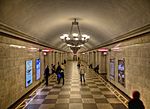Arctic and Antarctic Museum
1930 establishments in RussiaAntarctic researchArctic researchArt museums and galleries in Saint PetersburgEuropean museum stubs ... and 7 more
Museums established in 1930Natural history museums in Saint PetersburgPolar exploration by Russia and the Soviet UnionRussia and the AntarcticRussian building and structure stubsScience museums in Saint PetersburgSoviet Union and the Antarctic

The Russian State Arctic and Antarctic Museum (Russian: Российский государственный музей Арктики и Антарктики) is a museum in St. Petersburg, Russia. It was established in November 1930 as part of the Soviet Arctic and Antarctic Research Institute, but was not opened until six years later.The museum is located in Avraam Melnikov's Neoclassical church from the 1820s and remains the largest museum dedicated to polar exploration in the world. The current director of the museum is Victor Boyarsky.
Excerpt from the Wikipedia article Arctic and Antarctic Museum (License: CC BY-SA 3.0, Authors, Images).Arctic and Antarctic Museum
Marata Street, Saint Petersburg
Geographical coordinates (GPS) Address Phone number Website External links Nearby Places Show on map
Geographical coordinates (GPS)
| Latitude | Longitude |
|---|---|
| N 59.927505555556 ° | E 30.353594444444 ° |
Address
Музей Арктики и Антарктики
Marata Street 24А литА
191040 Saint Petersburg (Владимирский округ)
Saint Petersburg, Russia
Open on Google Maps











